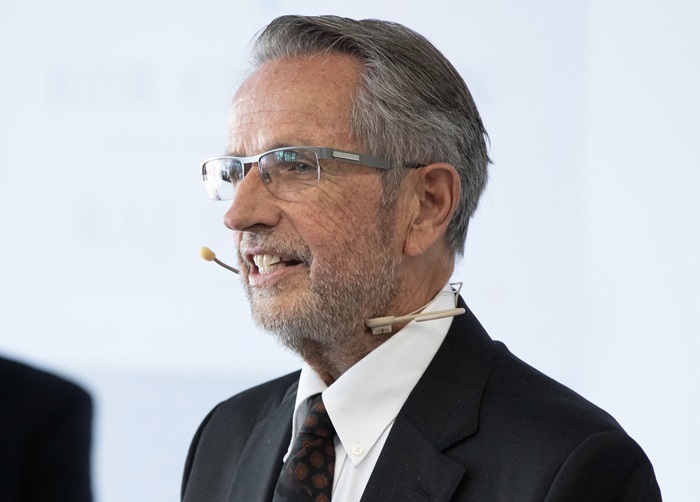HeartPoint Global’s ROI Is Survival for Children with Congenital Heart Disease
By Seth Bogner | October 26, 2023 6:08 pm
CEO Seth Bogner vows to serve small but important market and overcome regulatory hurdles.

“As HeartPoint Global moves forward to the next step of in-human trials, I am optimistic about the difference that medical technology will make in solving the problem of inequity and lack of access for those that need it most acutely.” – Seth Bogner (Photo: HeartPoint Global)
As a social capital entrepreneur, I believe in reinventing capitalism in the way that a company embeds a compassionate ethos into its business plans, encompassing its products and services, as a catalyst for systemic change. To that end, a problem that my company, HeartPoint Global, has been focusing our efforts on is reducing the mortality rate for children and adolescents with congenital heart disease.
The U.S. population of all-cause mortality between children and adults is rising, according to the Journal of the American Medical Association, which found rising mortality rates among U.S. children and adolescents between one and 19 years old. A lot of these deaths stem from mental health issues, gun usage, etc. The Financial Times, in a recent article entitled “Why are Americans dying so young?,” also noted that America’s mortality problem is driven primarily by deaths among the young, and one in 25 American five-year-olds today will not make it to their 40th birthday, with the highest price being paid among the young, poor and vulnerable.
I could not agree more with health economist Jane Sara Sohn-Kahn, who recently cited this data on her blog HealthPopuli, and summoned a call for action to “become engaged with citizens and to see our neighbors.” At HeartPoint Global, we are occupied with this effort, through an ethos of respect for people and viewing human flourishing as the ultimate definition of successful capitalism while simultaneously increasing revenue.
While this rising mortality rate is associated primarily with societal and environmental factors, according to the American Academy of Pediatrics, congenital heart disease is the most common cause of infant death due to birth defects, and 25% of babies born with complex congenital heart disease will not see their first birthday. According to the CDC, 4.2% of all deaths in the first 27 days of life were due to a congenital heart defect and about one in four babies with a CHD have a critical CHD. Infants with critical CHD’s generally need surgery or other procedures in their first year of life.
Pediatric Care and Research Severely Limited
For Juvenile Congenital Heart Disease, current medications are not curative, have limited efficacy and do not normalize life expectancy or functional capacity. Although improving, the development of drugs and devices for children is still less effective than for adults, according to an article in the National Library of Medicine. To compound this problem, pediatric drug and device development is very limited because there is not as much of a financial incentive and there is high regulatory hurdles to overcome by the private sector; and, while there is more being done by the private and public sectors, a lot of the research is currently being conducted by charities, nonprofits and academic institutions.
This inequality is more pronounced in the developing world, as 90% of children in these countries do not have access to treatment, and pediatrics often gets both the short end of the stick when it comes to money dedicated to it and all the regulatory challenges, making speed to market very slow.
Overcoming Barriers to Entry
This is also another reason why I am passionate about developing this device for pediatric patients. With high mortality rates and the sobering reality that there are so many barriers to entry in the development and funding of devices for this age group, I wanted to use my expertise in business to make a difference.
At HeartPoint Global, we found a way to help alleviate this problem by choosing to focus initially on pediatric medicine to achieve regulatory approval in a shorter timeframe. We want to not only help kids, but this will eventually help adults. There has been erratic movement in the development of devices because of the difficulties necessary for doing clinical trials for kids and because it is a much smaller market than focusing on problems facing adults.
We have found that it is beneficial to develop a device for kids with pediatric issues. It will not only benefit our business but will help juveniles who need treatment — because it will be a quicker path to regulatory approval from agencies like the FDA. The FDA recognizes that there is a shortage of companies working on devices and medication for pediatrics.
Factors of Cost and Availability
A few years ago, I met with an interventional cardiologist at his office, where he had a cardiac guidewire on a wall behind his desk. When I asked why he had a guidewire on the wall, he said it had been used for surgery more than 200 times in Myanmar, demonstrating a critical shortage of supplies and expertise in most of the developing world. Typically, one would use a guidewire once and dispose of it after it is used. The cardiologist was so blown away by the fact that they used the guidewire 200 times that he had to memorialize it. I was inspired and motivated by my desire to bring easy-to-use technology to the developing world for people who often cannot afford or do not have access to surgery that we take for granted in western countries.
In the United States, an artificial heart device costs one million dollars. Our device costs four thousand dollars. When we started, we were driven by blue babies, kids with congenital heart disease and holes in their hearts. We wanted to increase the chances of survival for these kids. Our vision is to train general surgeons and cardiologists to do our procedure and develop a noninvasive treatment to replace open heart surgery in some cases or, in others, to assist the heart to heal itself. We want to treat kids in underprivileged parts of the world who cannot receive proper treatment for these conditions.
Fast forward: HeartPoint Global (HPG) now creates breakthrough medical devices to treat numerous life-threatening cardiovascular diseases that affect millions worldwide each year. I started HeartPoint Global to focus on improving the structure of the heart and the heart-lung system for adults, but it is evident that the need is most pressing among children and adolescents.
Life-Saving Advances
HeartPoint Global now engages primarily in pulmonary hypertension caused by congenital heart disease, for which there is currently no effective treatment in left ventricular dilated cardiomyopathy in juveniles. This new center of attention will address the evident need for treatment worldwide. Once approved for public use, this life-saving device will be distributed in both the developing and developed worlds, with an immediate focus on patients who do not have access to cardiac care.
Intellistent is the first and only patented, non-surgical, structural heart system that addresses a variety of life-threatening cardiovascular diseases in pediatric patients. The device works in the case of pulmonary arterial hypertension caused by congenital heart disease (PAH-CHD), which results in pulmonary overflow, to reproduce the surgical effects of a pulmonary banding procedure with much lower surgical risk by restoring pulmonary flow and pressure.
The Intellistent system of stents is intended to adjust pulmonary blood flow via a percutaneous intervention with a self-expanding nitinol stent to treat PAH-CHD. It applies the principles of an effective surgical operation without the need for an invasive procedure — and it can modulate the therapy for juvenile patients to achieve personalized, safer treatments. The reduction of symptoms will include less coughing, chest pain, dizziness, dyspnea and palpitations; improvements of hemodynamics; increased ejection fraction; and improvement of oxygenation.
As HeartPoint Global moves forward to the next step of in-human trials, I am optimistic about the difference that medical technology will make in solving the problem of inequity and lack of access for those that need it most acutely, Equally as important, I am excited about the potential to give deserving young people a chance to become contributors to the world themselves, using their talents to bring hope and healing — per Jewish concept of “tikkun olam” — and “repair a broken world.”
With the increased mortality rates in America, HeartPoint Global’s goal is to lower mortality rates both in the U.S. and globally.
Seth Bogner is chairman and CEO of HeartPoint Global, Inc. Look for our exclusive Social Capital interview with him to come.




